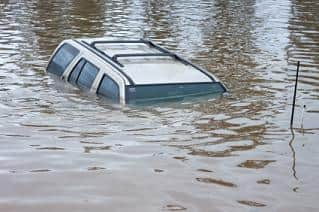Tips for spotting a flood-damaged car
|
Whether you live close to a recent flood or across the country, you might feel the effects of the flood (due to torrential rains, hurricane or a tropical storm) if you go to buy a used car: You can expect water-damaged cars to make their way to your region.
A consequence of any major flood is an onslaught of flood-damaged cars that appear on the used-car market, as car owners try to unload their flood-damaged vehicles onto unsuspecting buyers.
When a car gets caught in a flood, you might expect that once it dries out it simply sputters to the salvage yard and stays. Think again.
Sometimes flooded cars are totaled by a car insurance company, sold through auto-salvage auctions, shipped hundreds of miles away, and cleaned up by dealers for resale.
You can avoid flood cars and the myriad problems lurking beneath their hoods — if you know what to look for.
It doesn’t take a trained nose to recognize a flood-damaged car. If the car doors have been closed and the car has been sitting out in the sun, the interior will have a strong musty odor. Bad odors are mainly due to moisture-laden carpet padding. Unless the carpet is removed and shampooed, the musty smell will never fully disappear.
However, not all flood cars reveal their true nature by aroma. Unscrupulous car dealers will mask water-damage smells with deodorants and the scent of “fresh mountain air.” If that’s the case, warning bells should sound in your head and you should look for other signs of water damage. Basically, if a car smells too good, investigate further.
Problems imminent with flood cars
A flood-damaged car doesn’t always reveal its shortcomings right away. Engine, transmission, and wheel and brake damage can develop just weeks after you purchase your “new” car.
 If the car was totally submerged, it is wise to walk away from it. The vehicle could have been in sewer water, sandy water, or relatively debris-free water. Regardless, if water seeped into the engine or transmission, long-term problems are bound to crop up. For example, if the water carried sand into the engine, misfiring and blown gaskets could be just around the corner.
If the car was totally submerged, it is wise to walk away from it. The vehicle could have been in sewer water, sandy water, or relatively debris-free water. Regardless, if water seeped into the engine or transmission, long-term problems are bound to crop up. For example, if the water carried sand into the engine, misfiring and blown gaskets could be just around the corner.
Additionally, submerged vehicles will often develop electrical problems, if not immediately a few months down the road. Electrical components that operate erratically is a red flag. If looking at a used vehicle, try out the power windows, power locks, power seats, windshield wipers, heating and air conditioning.
There is also a chance you could get sick if you’re driving a car that was submerged in sewer water. Unless your dealer removed the vehicle’s carpet and padding and disinfected the interior, high bacteria levels are possible. Mold and mildew growths are never good for you or your family’s health.
Are all flood-damaged cars bad?
Not all flood-damaged cars are pariahs. You can still get a quality car if it has been cleaned and restored properly. That includes: removing the vehicle’s interior, including seats; removing the carpet padding and replacing it; disinfecting the car; changing the seat foam and shampooing the carpet; greasing all electrical connections; and replacing any corroded wires or components.
However, you want to make sure that the vehicle has been repaired properly. Take your car for a prepurchase inspection to a reputable mechanic before buying a car that might drown you in problems.
Also, before buying any type of branded-title vehicle, check that you can get car insurance. Not all auto insurance companies will sell you a policy on a flood-titled car, but some may offer to sell you a liability policy but no collision or comprehensive coverage. Liability will cover state-mandated coverages, but not cover your vehicle if it is damaged in the future. If you do find an insurer that will offer you comp and collision, remember that preexisting issues that may surface later would not be covered.
If you’re suspicious about whether or not a car you’re thinking about buying has indeed been in a flood, you can pay for a vehicle history from services such as CarFax.com or AutoCheck. There’s also the free National Motor Vehicle Title Information System and VINCheck from the National Insurance Crime Bureau.
Keep in mind that the car’s title will show that it’s been in a flood only if it was officially totaled by an auto insurance company and different states have different ways they brand a title. Doing a little research into where your used car came from can keep you from having a lot of headaches down the road.





